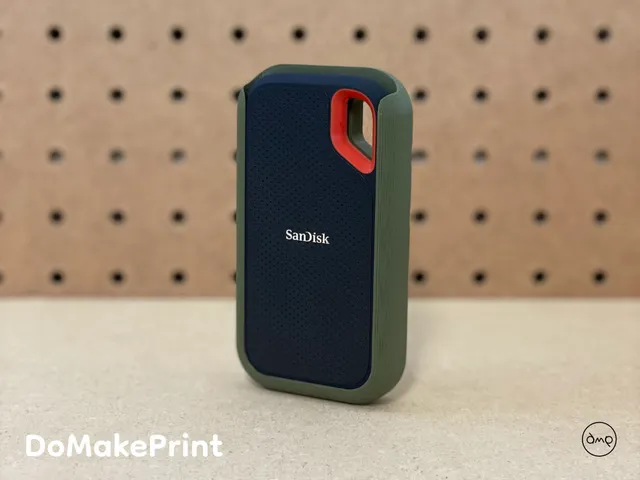
SanDisk Extreme Portable SSD (SDSSDE61) Compact Case
prusaprinters
ProjectA compact case for the SanDisk Extreme Portable SSD (SDSSDE61) that holds the SSD, USB-C cable, and USB-A adapter. Cable and adapter fit comfortably in the case while the SSD has a snug fit and will not slide out accidentally.The thickness of the case is a little less than double the original size of the SSD with an overall 6 millimetres added to the length and width. The design of the case was made to mimic the curved edges of the SSD resulting in a heavy fillet on the back of the case which may prove difficult to print smoothly. *** Update 2024/08/07 ***Due to slight variations in cable length shipped with the SSD, the following has been added to accommodate cables up to 92.5 mm (an increase of 2.5 mm).SanDisk.Compact.Case.SDSSDE61.V2.stlSanDisk.Compact.Case.SDSSDE61.V2 [0.4n-0.20-015-PLA-34g-3h26m].gcodeSanDisk.Compact.Case.SDSSDE61.Chamfer.V2.stlSanDisk.Compact.Case.SDSSDE61.Chamfer.V2 [0.4n-0.20-015-PLA-34g-3h26m].gcode *** Update 2024/06/08 ***The following has been added for printing with no supports:SanDisk.Compact.Case.SDSSDE61.Chamfer.stlSanDisk.Compact.Case.SDSSDE61.Chamfer [0.4n-0.20-015-PLA-34g-3h26m].gcode PrintingGeneralA nozzle diameter of 0.4 mm and a layer height of 0.20 mm are recommended. Supports after the first 3 millimetres are unnecessary as it prints fine without them. Use a support blocker to save time and filament. OptionalAdd two height range modifiers to enable ironing between layers 1.40 - 1.60 mm and 8.50 - 8.60 mm. Ironing the last few top layers of the case can produce undesirable results. FilletThe reasoning behind the choice of printer settings is to achieve a smooth fillet off the printer bed with minimal post processing. The grid style support option and a top contact Z distance of 0 (soluble) were selected to better guarantee a smooth print line. A pattern angle of 45 degrees ensures supports are not parallel with perimeter lines and makes removing supports easier. The other settings help create a shelf close enough that the overhangs have enough surface area to print on resulting in a line that does not sag. Support RemovalThe supports are mostly attached to the bottom layer of the case as shown in the below images. Carefully use needle nose pliers to pry them away from the print. Support CleanupThe supports will leave behind white marks that can be removed by applying a torch/flame for a split second to the affected areas.While not prefect, the fillet is satisfactory for the amount and ease of post processing. Perhaps a smoother curve could be achieved with more time spent tinkering with printer setting.The supports have been tested across four brands to varying degrees of success.1. PLA, Eryone Matte Olive Green: Supports removed with minimal effort.2. PLA, Geeetech Silky Gold: Supports removed effortlessly.3. PLA, AMZ3D Lavender: Supports removed with more effort.4. PETG, AMZ3D Green: Supports removed with more effort and small damage*.* Damage occurred on a weak point due to how the model was cut for testing. Printing the full case may result in a better outcome.The included gcode has an 11 minute Support Test file that can be used to quickly check if the intended filament will work with this project. Results may vary depending on brand of printer and filament. ChamferIncluded in this project is an STL with a chamfer on the bottom instead of a fillet for a support-free print. Select the chamfered STL if printing the fillet version ends in poor results or failure. Print Time (Approximate)SanDisk Compact Case SDSSDE61(0.4 mm Nozzle, 0.20 mm layer height, 15% Infill, Ironing, 36.23 g): 3 hours 52 minutes SanDisk Compact Case SDSSDE61 (Chamfer)(0.4 mm Nozzle, 0.20 mm layer height, 15% Infill, Ironing, 33.47 g): 3 hours 26 minutes Support Test(0.4 mm Nozzle, 0.20 mm layer height, 15% Infill, 2 g): 11 Minutes Printer SettingsPrusaSlicer: Version 2.7.4Printer: Prusa MK3SMaterial Used: Eryone Matte Olive GreenTemperature (Nozzle): 210Temperature (Bed): 60Nozzle: 0.4 mm Layer Height: 0.20 mmFill Density: 15%Supports: YesSupport Blocker Used: Yes Layers and Perimeters -> Vertical ShellsPerimeters: 4Support Material -> Options for Support Material and RaftsStyle: GridTop Contact Z Distance: 0 (soluble)Pattern: RectilinearPattern Angle: 45 DegreesTop Interface Layers: 3 (heavy)Interface Pattern Spacing: 0 mmSupports on Build Plate Only: YesXY Separation Between an Object and its Support: 30%Synchronize with Object Layers: Yes Advanced -> Extrusion WidthExternal Perimeters: 0.4 mm FilesSanDisk.Compact.Case.SDSSDE61.stlSanDisk.Compact.Case.SDSSDE61.Chamfer.stl UsageWhen sliding the SSD into the case, hold both horizontally and apply pressure to the top of the SSD and bottom of the case until it is fully seated. Any pressure to the sides of the case will constrict the enclosure and make it harder to push the SSD in. To remove, pull the SSD from the carabiner loop while securely holding the bottom of the case. DisclaimerDesigned for the SanDisk Extreme Portable SSD 1TB USB 3.2 Gen 2 (SDSSDE61-1T00). The 2TB and 4TB models have the same dimensions as the 1TB so they should fit in this case but have not been tested.The USB 3.2 Gen 2x2 Pro version is slightly larger and will not fit in this case.
With this file you will be able to print SanDisk Extreme Portable SSD (SDSSDE61) Compact Case with your 3D printer. Click on the button and save the file on your computer to work, edit or customize your design. You can also find more 3D designs for printers on SanDisk Extreme Portable SSD (SDSSDE61) Compact Case.
